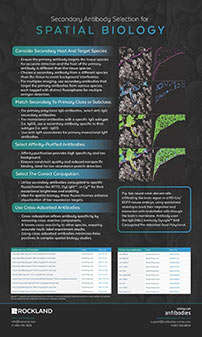Secondary Antibody Selection for Spatial Biology
By integrating spatial information into biological studies, spatial biology offers a more holistic and comprehensive understanding of how biological systems operate. It provides insights into the complex interplay between cellular and molecular components and how they contribute to the overall function and behavior of living organisms.
-
Consider Secondary Host And Target Species:
- Ensure the primary antibody targets the tissue species for accurate detection.
- Choose a secondary antibody from a different species than the tissue to avoid background interference.
- For multiplex imaging, use secondary antibodies that target the primary antibodies from various species, each tagged with distinct fluorophores for multiple antigen detection.
-
Match Secondary To Primary Class:
- Select anti-IgG secondary antibodies for primary polyclonal IgG antibodies.
- Choose anti-IgM for primary monoclonal IgM antibodies.
-
Select Affinity-Purified Antibodies:
- Affinity purification provides high specificity and low background.
- Ensures consistent quality and reduced nonspecific binding, ideal for low abundance protein detection.
-
Select The Correct Conjugation:
- Utilize secondary antibodies conjugated to specific fluorochromes like FITC, DyLight™, or Cy™ for their exceptional brightness and stability.
- Ideal for spatial biology, these fluorochromes enhance visualization of low-expression targets.
-
Use Cross-Adsorbed Antibodies:
- Cross-adsorption refines antibody specificity by removing cross-reactive components.
- It lowers cross-reactivity to other species, ensuring accurate multi-label experiment results.
- Using cross-adsorbed antibodies minimizes false positives in complex spatial biology studies.
